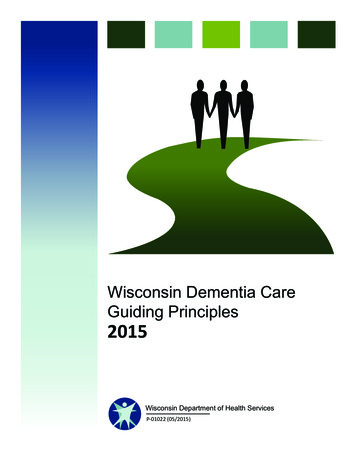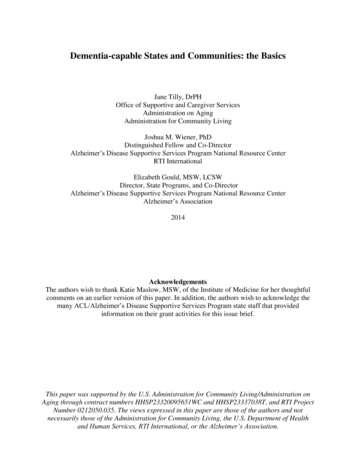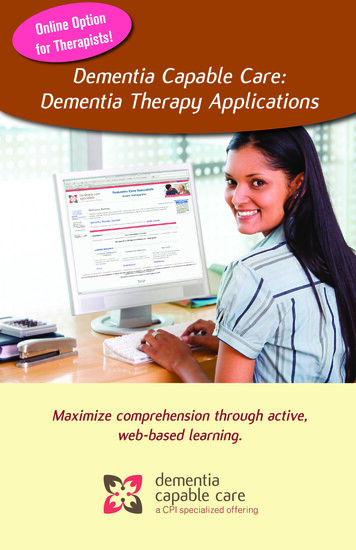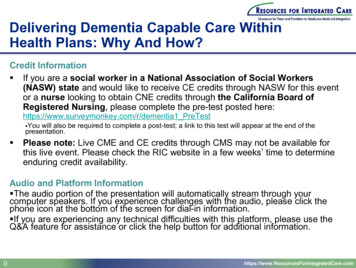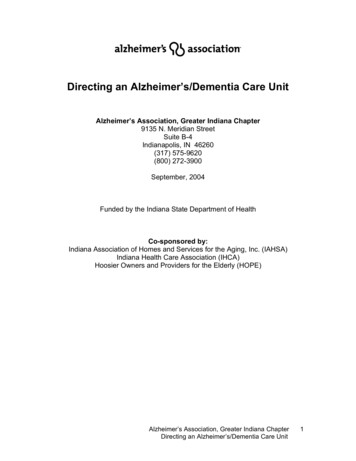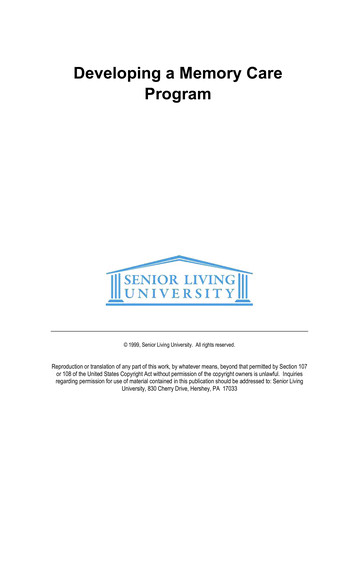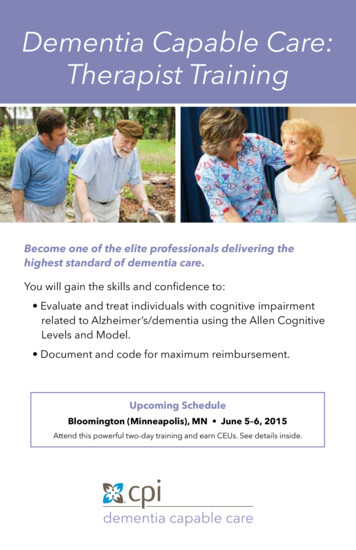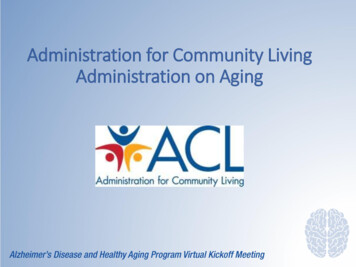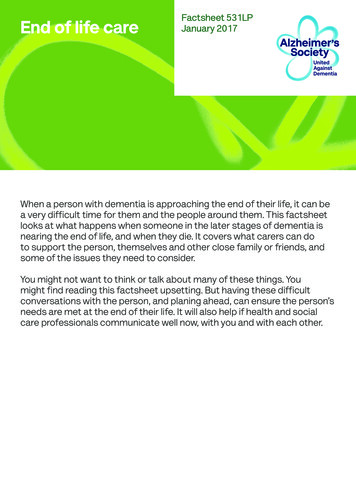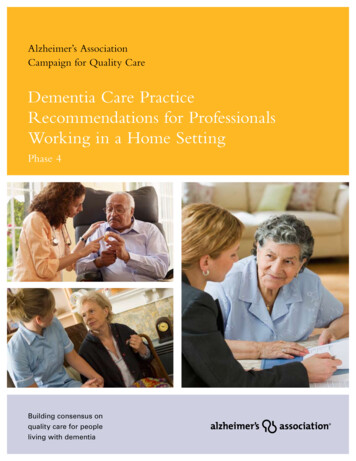
Transcription
Alzheimer’s AssociationCampaign for Quality CareDementia Care PracticeRecommendations for ProfessionalsWorking in a Home SettingPhase 4Building consensus onquality care for peopleliving with dementia
The Alzheimer’s Association is the leading voluntaryhealth organization in Alzheimer care, support andresearch.Our mission is to eliminate Alzheimer’s diseasethrough the advancement of research; to provideand enhance care and support for all affected; and toreduce the risk of dementia through the promotionof brain health. 2009 Alzheimer’s Association. All rights reserved.This is an official publication of the Alzheimer’s Association but may bedistributed by unaffiliated organizations and individuals. Such distributiondoes not constitute an endorsement of these parties or their activities bythe Alzheimer’s Association.For more information, visit www.alz.org or contact:Elizabeth Gould, M.S.W.National OfficeAlzheimer’s Association225 N. Michigan Ave., Fl. 17Chicago, IL 60601-7633Phone: 312.335.5728elizabeth.gould@alz.orgThe Alzheimer’s Association offers quality careeducation programs for professionals who work innursing homes, assisted living residences and homesettings. For more information, call 1.866.727.1890or visit www.alz.org/qualitycare.
Table of ContentsIntroduction 5D e m e n t i a a n d I t s E f f e c t s 71: T h e B a s i c s o f G o o d H o m e C a r e 8Ten Warning Signs 8Communication with Individuals and Family 103 : S a f e t y a n d P e r s o n a l Au t o n o m y 40Dementia Considerations 40Care Goals 41Recommended Practices 414: Home Safet y 43Involvement of Family and Support Services 11Dementia Considerations Behaviors 12Care Goals 4315Recommended Practices 43Decision-Making General Home Care Planning and Provision 2: Personal Care Guide 1719Social Relationships and Meaningful Interaction 19Dementia Considerations 19Care Goals 19Recommended Practices 19Pain Management 22Dementia Considerations 22Care Goals 23Recommended Practices 23Personal Care 25Dementia Considerations 25Care Goals 25Recommended Practices 25Bathing 26Oral Care 27Dressing 2743Home Environment 43General Safety 43Fall and Accident Prevention 44Bathroom Safety 44Medication Safety 44Kitchen Safety 45Food Safety 45Guns and Firearms 455 : E n d - o f - Li f e C a r e 46Dementia Considerations 46Care Goals 46Recommended Practices 46Communication with Individuals and Family 46Assessment and Care for Physical Symptoms 47Assessment and Care for Behavioral Symptoms 49Emotional and Spiritual Support 49Family Participation in End-of-Life Care 50Grooming 286 : H o m e C a r e P r ov i d e r T r a i n i n g 51Toileting 287: Sp e c i a l T o pi c s 53 29Making the Most of a Home Visit 53Dementia Considerations 29Considerations for Those Who Live Alone 53Care Goals 30Clinical Medication Management 54Recommended Practices 30Transitions in Care 55Falls 32Elder Abuse and Neglect 56Dementia Considerations 32Caregiver Stress 57Care Goals 33Travel Outside of the Home 57Recommended Practices 33Emergency Preparedness 58WanderingEating and Drinking 36Provider Self-Care 59Dementia Considerations 368: Glossary 61Care Goals 37 37Recommended Practices1
Campaign OverviewFor more than 25 years, the Alzheimer’sAssociation has been committed to advancingAlzheimer research and enhancing care, educationand support for individuals affected by the disease.Building on our tradition of advocacy for improvingthe quality of life for people with dementia, welaunched the Alzheimer’s Association Campaignfor Quality Care in 2005.Approximately 70 percent of people withdementia or cognitive impairment are living athome. To better respond to their needs, wehave joined with leaders in dementia care todevelop the evidence-based Dementia CarePractice Recommendations for ProfessionalsWorking in a Home Setting. The home settingrecommendations, in addition to those namedbelow, are the foundation of the campaign.Each year we focus on a different set of carerecommendations that can make a significantdifference in an individual’s quality of life.Our Phase 1 recommendations focus on the basicsof good dementia care, food and fluid consumption, pain management and social engagement.Phase 2 covers wandering, falls and physicalrestraints. Phase 3 covers end-of-life care practicesand issues. And Phase 4 addresses all of thesepractices as they relate to the home setting.To date more than 30 leading health andsenior care organizations have expressed supportand acceptance for one or more phases of theDementia Care Practice Recommendations.We are grateful to these organizations for theircounsel during development of the recommendations and for helping to achieve consensus inour priority care areas.2S t r at e gi e s f o r Q ua l i t y C a r eAll aspects of our Quality Care Campaign — fromthe selection of priority care practice areas to thedevelopment of recommendations, educationalprogramming and advocacy — are based on thebest available evidence on effective dementia care.We are using four strategies to achieve the overallcampaign goal: To encourage adoption of recommended practicesin assisted living residences, nursing homes andhome settings, we advocate with dementia careproviders. To ensure incorporation of the practice recommendations into quality assurance systems for nursinghomes, assisted living residences and homesettings, we work with federal and statepolicymakers. To encourage quality care among providers, weoffer training and education programs to all levelsof care staff in assisted living residences, nursinghomes and home settings. To empower people with dementia and family caregivers to make informed decisions, we developedthe Alzheimer’s Association CareFinder . Thisinteractive, online tool educates consumers abouthow to select care providers and services and howto advocate for quality care.
Organizations Supporting the Dementia CarePractice Recommendations, Phase 4AARPAmerican Academy of Home Care PhysiciansAmerican Academy of Hospice and PalliativeMedicineAmerican Association of Homes and Servicesfor the AgingAmerican Dietetic AssociationAmerican Geriatrics SocietyAmerican Medical Directors AssociationAmerican Occupational Therapy AssociationAmerican Physical Therapy AssociationAmerican Society of Consultant PharmacistsCatholic Health AssociationCenter for Health ImprovementGerontological Advanced Practice NursesAssociationHospice and Palliative Nurses AssociationNational Association for Home Care andHospiceNational Association of Social WorkersNational Gerontological Nursing AssociationNational Hospice and Palliative CareOrganizationNational Private Duty AssociationPHIAmerican Speech-Language-HearingAssociation accepts the recommendationsWe are enlisting the support of these and other organizations, as well as consumers and policymakers, to help us reach the goal of our Quality Care Campaign — to enhance the quality of life forpeople with dementia by improving the quality of dementia care in assisted living residences,nursing homes and home settings.3
Phase 4
Introduction to DementiaCare Practice RecommendationsPhase 4Edited by Elizabeth Gould, M.S.W., Jane Tilly, Dr. P.H., and Peter Reed, Ph.D.Dementia Care Practice Recommendationsfor Professionals Working in a Home Settingis the latest in a series of dementia care practicerecommendations offered by the Alzheimer’sAssociation. Three previously published manuals(Phases 1, 2 and 3) provide recommendationsfor care in nursing homes and assisted livingresidences.This manual offers best practice recommendationsfor professionals providing care in a home setting.The recommendations represent the latestresearch as well as the experience of care experts.Specifically, the Association used the followinginformation to develop its home care practicerecommendations: A summary of research findings from Dementia,a NICE-SCIE Guideline on Supporting Peoplewith Dementia and Their Carers in Health andSocial Care; commissioned by the National Institutefor Health and Clinical Excellence (NICE) and theSocial Care Institute for Excellence (SCIE) andpublished by The British Psychological Societyand Gaskell in 2007. The combined knowledge of Alzheimer’sAssociation chapter members, its early stageadvisor team, and experts from more than 20national associations. These individuals workedcollaboratively to translate research, knowledgeand experience into practical recommendationsfor those providing care in the home.Underlying the home care practice recommendations is a person- and family-centered approachto dementia care. This approach involves tailoringcare to the abilities and changing needs of eachperson affected by the disease. It also respectsthe cultural values and traditions of each family andcounts family members as part of the care team.The recommendations emphasize the importanceof personalized care and relationship building.Providers are encouraged to learn about anindividual’s cultural background, personal history,abilities, and care choices in order to makeinformed decisions and build rapport. They arealso encouraged to build strong relationships withfamily members who are part of the care teamand to understand the family’s choices concerningcare. Providers who have good dementia training willbe most effective in delivering personalized care.This manual is divided into eight main sections.Following a brief introduction and general description of dementia and its effects, the first sectionprovides an overview of good home care. ThePersonal Care Guide that follows is at the heart ofthe manual. It defines dementia considerations,care goals and recommended practices relatedto a broad range of care topics. The recommendedpractices for each topic include guidelines forassessment, suggested provider approaches and,where applicable, tips for modifying the environment. Additional sections on personal autonomy,home safety and end-of-life care supplementthe Personal Care Guide using the same approach.Sections on home care provider training, specialtopics and a glossary of terms complete the manual.5
Use of the Terms “Provider” and“Family Caregiver”There are a variety of paid “providers” who carefor people with dementia in their home. Paid homecare providers can range from professionals (e.g.nurses and therapists) and paraprofessionals(e.g. personal care aides), to non-medical persons(e.g. homemakers and chore services workers)who deliver services to persons with dementia.These providers may function independently or asmembers of a care team. For the purpose of thesepractice recommendations, the focus is primarilyon those providers who are part of a team, participate in care planning meetings and provide caredetermined by a formal care plan(s). In somecases, there is reference to a specific discipline orlevel of care provider such as direct care provider(including certified nursing assistants, home healthaides and personal care assistants), professionalpractitioner (including nurses, social workers andrehabilitation therapists), or supervisor.Throughout this document, the term “familycaregiver” refers to any family member, partner,friend, or other significant person who provides ormanages the care of someone who is ill, disabledor frail. There may be more than one family caregiver involved in a person’s care.6
Dementia and Its Effects on the Personwith the Disease and Family CaregiversDementia is an illness that affects the brain andeventually causes a person to lose the ability toperform daily self care. All areas of daily living areaffected over the course of the disease. Over time,a person with dementia loses the ability to learnnew information, make decisions, and plan thefuture. Communication with other people becomesdifficult. People with dementia ultimately losethe ability to perform daily tasks and to recognizethe world around them.In the beginning of the disease, the personmay be aware of some changes in memory andrely more on others for reminders. As dementiaworsens, the person may get lost easily and beunable to drive or manage finances. In advanceddementia, the person will lose the ability to eat,drink, bathe, dress, or use the toilet withoutassistance. Eventually, someone who is dying ofdementia may not be able to swallow safely, talk,or get out of bed and will be totally dependent onothers for help with every daily activity. Throughoutthe course of the disease, individuals may becomesad, agitated, wander or resist care. These behaviors are a form of communication that signifies theperson’s emotional condition and reactions to care.Dementia also affects family caregivers.Seventy percent of persons with dementia live inthe community, and family caregivers are largelyresponsible for helping them to remain at home.Family caregivers must be vigilant 24 hours a dayto make sure that the person with dementia is safeand well. Their responsibilities include: housekeeping; shopping; managing finances; managingmedications; helping with daily activities, such aseating, drinking, bathing, and dressing; ensuringthat someone who wanders can do so safely; andoverseeing other health care needs which mayinclude conditions like diabetes or heart disease.Providing constant, complicated care to a personwith dementia takes a toll on family caregivers.Family members and other unpaid caregivers ofpeople with Alzheimer’s and other dementias aremore likely than non-caregivers to report that theirhealth is fair or poor. (Alzheimer’s Association2009 Alzheimer’s Disease Facts and Figures)7
1The Basics of Good Home CareEach person with dementia has a unique set ofabilities and care needs that change over time asthe disease gets worse. Yet, even when thedisease is most severe, the person can experiencejoy, comfort, and meaning in life. The quality of lifedepends on the quality of the relationships peoplewith dementia have with their loved ones, theircommunity, and their home care providers.Ten Warning SignsStudies have shown that the signs of earlydementia are subtle. They can be mistaken fortypical age-related changes and easily missed bypatients, caregivers, and even physicians. Providersand family caregivers are often the first to seethese signs. Direct care providers need trainingnot only to recognize the signs but also to understand when and how to communicate changes tosupervisors, discuss observations with the homecare team, or consult with an external expert.Families can also benefit from education about thewarning signs. Family caregivers who witnesssigns of dementia should be referred to a physicianor other qualified practitioner.The Alzheimer’s Association has developed thefollowing “Ten Warning Signs”:1. M e m o r y c h a n g e s t h at d i s r u p t da i ly l i f e .One of the most common signs of Alzheimer’s,especially in the early stages, is forgetting recentlylearned information. Others include forgettingimportant dates or events; asking for the sameinformation over and over; relying on memory aids(e.g. reminder notes or electronic devices) or familymembers for things they used to handle on theirown. What are typical age-related changes?Sometimes forgetting names or appointments,but remembering them later.82 . C h a l l e n g e s i n p l a n n i n g o r s o lv i n gp r o b l e m s . Some people may experience changesin their ability to develop and follow a plan or workwith numbers. They may have trouble following afamiliar recipe or keeping track of monthly bills.They may have difficulty concentrating and takemuch longer to do things than they did before.What are typical age-related changes? Makingoccasional errors when balancing a checkbook.3 . Di f f i c u lt y c o m p l e t i n g fa m i l i a r ta s k s atPeople withAlzheimer’s disease often find it hard to completedaily tasks. Sometimes, people may have troubledriving to a familiar location, managing a budget atwork or remembering the rules of a favorite game.What are typical age-related changes?Occasionally needing help to use the settings ona microwave or record a television show.h o m e , at w o r k o r at l e i s u r e .Peoplewith Alzheimer’s can lose track of dates, seasonsand the passage of time. They may have troubleunderstanding something if it is not happeningimmediately. Sometimes they may forget wherethey are or how they got there. What are typicalage-related changes? Getting confused aboutthe day of the week but figuring it out later.4 . C o n f u s i o n wi t h t i m e a n d p l a c e .5 . T r o u b l e u n d e r s ta n d i n g v i s ua l i m ag e s a n ds pat i a l r e l at i o n s h ip s . For some people,having vision problems is a sign of Alzheimer’s.They may have difficulty reading, judging distance,and determining color or contrast. In terms ofperception, they may pass a mirror and thinksomeone else is in the room. They may not realizethey are the person in the mirror. What are typicalage-related changes? Vision changes relatedto cataracts.
6 . N e w p r o b l e m s wi t h w o r d s i n s p e a k i n g o rPeople with Alzheimer’s may havetrouble following or joining a conversation. Theymay stop in the middle of a conversation and haveno idea how to continue or they may repeat themselves. They may struggle with vocabulary, haveproblems finding the right word or call things bythe wrong name (e.g. calling a watch a “handclock”). What are typical age-related changes?Sometimes having trouble finding the right word.writing.7. Mi s p l ac i n g t h i n g s a n d l o s i n g t h e a bi l i t yt o r e t r ac e s t e p s . A person with Alzheimer’sdisease may put things in unusual places. Theymay lose things and be unable to go back overtheir steps to find them again. Sometimes, theymay accuse others of stealing. This may occurmore frequently over time. What are typicalage-related changes? Misplacing things fromtime to time, such as a pair of glasses or theremote control.People withAlzheimer’s may experience changes in judgmentor decision-making. For example, they may usepoor judgment when dealing with money, givinglarge amounts to telemarketers. They may payless attention to grooming or keeping themselvesclean. What are typical age-related changes?Making a bad decision once in a while.8 . D e c r e a s e d o r p o o r j u d g m e n t.Themood and personalities of people with Alzheimer’scan change. They can become confused, suspicious, depressed, fearful, or anxious. They may beeasily upset at home, at work, with friends or inplaces where they are out of their comfort zone.What are typical age-related changes?Developing very specific ways of doing things andbecoming irritable when a routine is disrupted.10 . C h a n g e s i n m o o d a n d p e r s o n a l i t y.Other conditions commonly associated withchanges in cognition in older adults, with andwithout dementia, include delirium and depression.When these conditions are suspected, theperson’s health care providers should be notifiedpromptly. Delirium is an acute, usually reversible, worseningof cognition characterized by inattention anddisorganized thinking along with altered levels ofconsciousness. Caregivers should look for asudden change in the person’s baseline mentalstatus. Depression is another common condition that,along with depressed mood or irritability, canbe associated with changes in memory. Memoryand depressed mood often improve withantidepressant therapy.9 . W i t h d r awa l f r o m w o r k o r s o c i a lA person with Alzheimer’s may startto remove themselves from hobbies, social activities, work projects or sports. They may havetrouble keeping up with a favorite sports team orremembering how to complete a favorite hobby.They may also avoid being social because of thechanges they have experienced. What are typicalage-related changes? Sometimes feeling wearyof work, family and social obligations.ac tiviti es.9
Communication with Individualsand FamilyTo ensure that home care is person-centered andaligned with an individual’s choices, there must begood communication among the individual livingwith the disease and his or her health care proxydecision-maker, family caregivers and entire careteam. Cultural perspectives on functioning anddisability may vary a great deal. To be effective,providers must understand the communicationchallenges presented by those living withdementia. They must also consider, what, howand when information should be delivered to familyand other team members.C o n n e c t i n g wi t h I n d i v i d ua l sConsider the following communication techniqueswhen communicating with a person who hasdementia: Introduce yourself by name Address the person by the name he or she prefers Approach the person from the front Speak to the person at eye level Speak slowly and calmly, and use short, simplewords Allow enough time for the person to respond(counting to five between phrases is helpful) Focus on the person’s feelings, not the facts Use a comforting tone of voice Be patient, flexible and understanding Avoid interrupting people with dementia; they maylose their train of thought Allow individuals with dementia to interrupt you, orthey may forget what they want to say Limit distractions during communication (e.g. turnoff the radio or move to a quiet place) Increase the use of gestures and other non-verbalcommunication techniques Observe the individual to recognize non-verbalcommunication10Ov e r c o m i n g C h a l l e n g e sLanguage, hearing or vision problems as well aslow levels of health literacy may present obstaclesto effective communication. Providers shouldtake the following issues into account for bothindividuals and family. A person with dementia may sometimes requiremore time to process information and may takelonger to respond to a question. Short sentences, visual cues or pictures may helpthe person with dementia understand what he orshe is hearing. Hearing loss is very common inolder adults and is often undiagnosed. Interpreters may be needed if English is not theprimary language or if the person with dementiauses sign language. Determine if the person with dementia or thefamily caregiver has difficulty hearing or seeing.Do they require a hearing aid or eyeglasses? Arethose items being used and are they effective? Some people may not be “health literate.”They may need help to understand some healthconcepts, terminology, or the implications oftreatment options. When health literacy is low,simple verbal explanations may be more effectivethan written information.T h e L a n g uag e o f B e h av i o rAll behaviors, including reactions to daily care, area form of communication. The direct care provideris responsible for interpreting and responding tobehaviors. For example: A person repeatedly refusing a certain food orbeverage may mean he or she does not like it.Simply changing the item may eliminate thisbehavior. If it persists, it is possible that the personhas trouble swallowing. This may require a feeding/swallowing evaluation.
A person who resists getting dressed may be inpain due to arthritis. Controlling for pain and/orminimizing physical movements that cause paincan address this behavior. A person who seems to misunderstand a lot ordoes not respond when spoken to may havehearing loss. Proper care and use of hearing aidsor other recommended assistive listening technology is important. A person who resists a bath may feel under attackwhen someone tries to help take off clothes.Giving the person a view of the tub, starting thebath water before undressing, and keeping thebathroom warm can promote participation inundressing.C o n n e c t i n g wi t h Fa m i ly Holding regular care planning meetings is important. As dementia progresses, they providerecurring opportunities to create understandingabout a person’s changing needs and to discussthe implications of those changes on care choices.Families need to know the symptoms of dementiaand understand the progression of the disease. Every family needs easy access to a home careteam that responds to its needs and questions.Schedules vary — providers come and go — socommunication can be difficult. Providers mustcoordinate their work with families and others,including a private care manager the family orinsurer hires. Responsive communication caninclude team meetings that involve family. It canalso include assigning a primary nurse or socialworker to the person with dementia, and keepingregular contact through home visits, phone calls, or(if available and appropriate) email, text messagesor other electronic technologies.Involvement of Family andSupport ServicesFamily members may play a vital role in helpinga person with dementia remain at home. Theyprovide a variety of support services and may betrained by the home care team to deliver skilledservices such as changing a sterile wound dressingor performing diabetes care. In addition, community-based services providing home-deliveredmeals, transportation or home modification oftenplay a role. This patchwork of support servicesrequires coordination and communication tobe successful.Family members may need assessment toidentify their own needs for education, supportand services and reassessment as the person’sdementia progresses or the caregiver’s healthand emotional well-being is impacted. A socialworker can refer families to community resourcessuch as the Alzheimer’s Association.Providers should take steps necessary tocomply with state and federal law concerningprivacy matters.NOTE :11
Providers must be aware and respectful of eachfamily’s culture. A family’s decision to use supportservices — and the types of services they use —may be influenced by its culture or by barriers tocare, such as limited English proficiency or a lackof support services in the community.C o m m u n i c at i o n T e c h n iq u e sConsider the following techniques whencommunicating with families: Make information clear and easy to understand Consider the family’s level of health literacy Reduce the amount of medical jargon and explainany unfamiliar terms Use visual aids and demonstration whenappropriate Clearly explain dosages and when medicationsshould be given When appropriate, provide printed information inthe family’s preferred language, and use interpreters if necessary Check for comprehension by having the personwith dementia and the family caregiver repeatinstructions in their own words Hold routine home care meetingsH o m e C a r e M e e t i n g sRoutine home care discussion with caregivers mayinclude the following topics: Changes anticipated as the disease progresses —what to look for, when to contact a doctor,information on delirium and ongoing monitoring Care goals and possible adjustments over time Preparing for loss of decision-making capacity Wandering risks and precautions Actions that place patient or family at risk of harm Altered sleep/wake cycle12 Incontinence Recognizing and managing pain Risks for falls Alternatives to restraints Diet and meals; signs of swallowing difficulty Preparation of foods the person can eat safely Caregiver stress and use of respite Safety issues such as driving a carBehaviors Most persons with dementia will experiencebehavioral symptoms. Early on, people may have ahard time concentrating and experience irritability,anxiety or depression. Later in the disease othersymptoms may occur, including: sleep disturbances, outbursts, emotional distress, paranoia,delusions (belief in something not real) or hallucinations (seeing, hearing, or feeling things that are notthere). These symptoms are hard on people andtheir caregivers. These behaviors and the emotional state ofpersons with dementia are most often forms ofcommunication because they cannot make theirneeds known in other ways.E X AM P LE :A person may resist getting dressedbecause of joint pain due to arthritis but he or shecannot express this discomfort in words.B e h av i o r a l Sy m p t o m s — C au s e sand Care A person showing behavioral symptoms needsa thorough medical evaluation especially whensymptoms come on suddenly. If an examinationis not performed and symptoms are treatedwith drugs, the medication could not only maskthe symptom but also create a much moredangerous situation.
E X AM P LE : A person exhibiting distressed behaviorsmay actually have an underlying urinary tractinfection that should be treated with antibiotics. Theuse of psychotropic medication in this case wouldmask behaviors and leave the underlying causeuntreated. Behavioral symptoms can also have non-medicalcauses. These causes include: a change in theperson’s care, such as admission to a hospital;a change in care provider; the presence of houseguests; or a request to bathe or change clothesat a different time of day. Assessment shouldalso address personal comfort, pain, hunger,thirst, constipation, full bladder/bowel, and fatigue.Loss, boredom and isolation can also causebehavioral symptoms. An environmental assessment of the homedirected at possible hazards is appropriate.A comfortable, simple, clutter-free environmentcan reduce behavioral symptoms. Creating acomfortable environment can involve adjustingroom temperature, providing supportive seating,eliminating glare, reducing noise levels and offeringenjoyable activities (e.g. listening to music orreading). Providers should help families understandthe importance of a comfortable homeenvironment. If behavioral symptoms are related to caremethods, focus on unmet needs. Use gentle caregiving techniques including:warnings before touching a person or beginningcare, apologies for causing distress and keepingthe person covered and warm. Listen to and validate the person’s concerns,address those concerns, and providereassurance. Providers and family need to be able to recognizebehavioral symptoms of dementia. Direct careproviders need to com
level of care provider such as direct care provider (including certified nursing assistants, home health aides and personal care assistants), professional practitioner (including nurses, social workers and rehabilitation therapists), or supervisor. Throughout this document, the term
